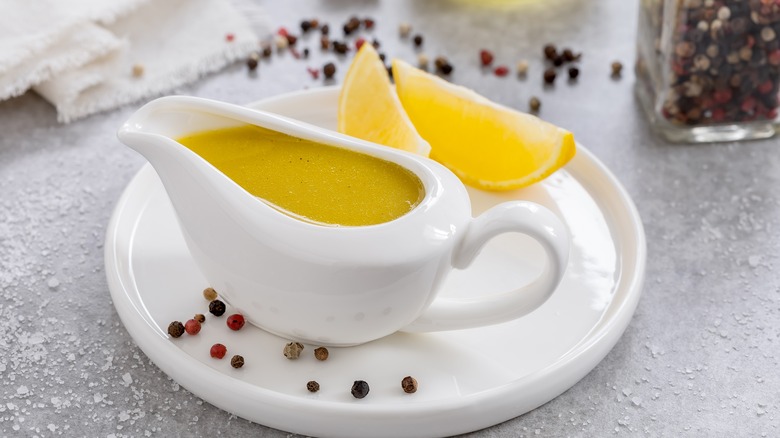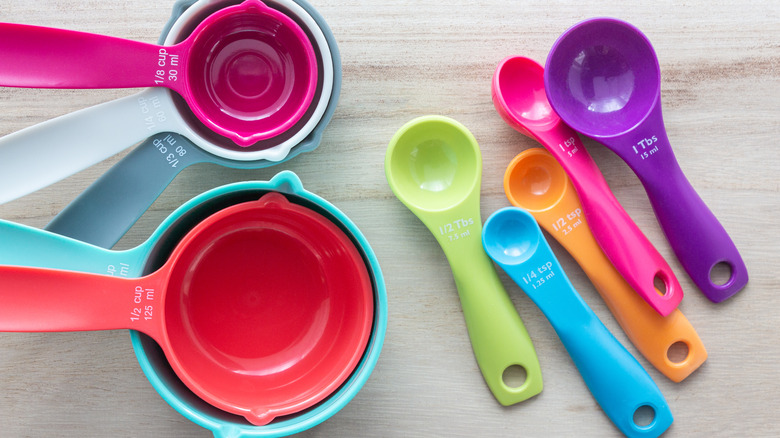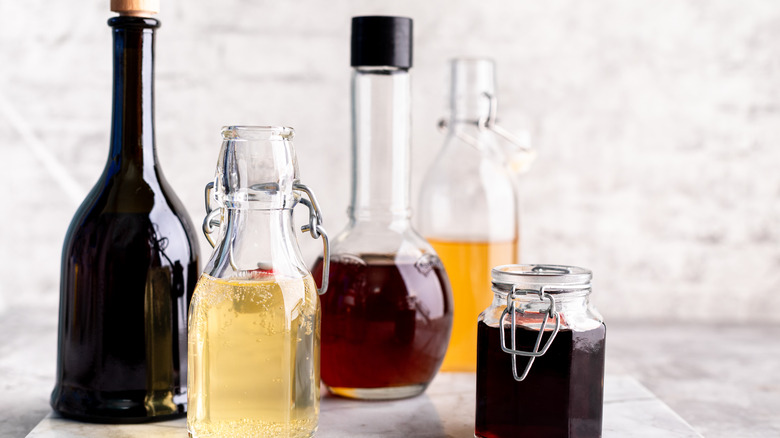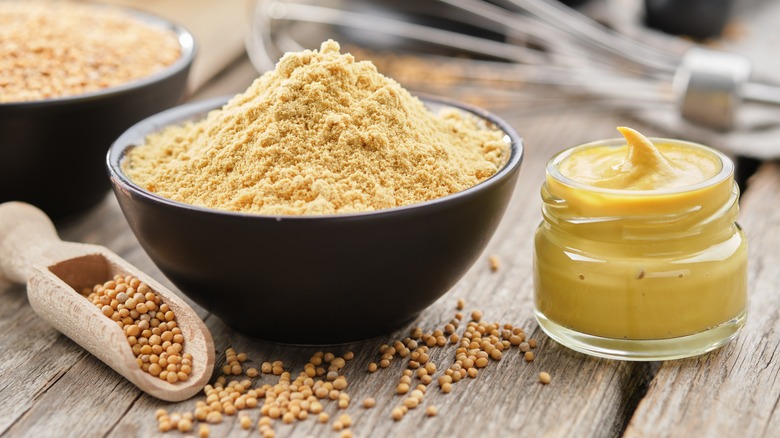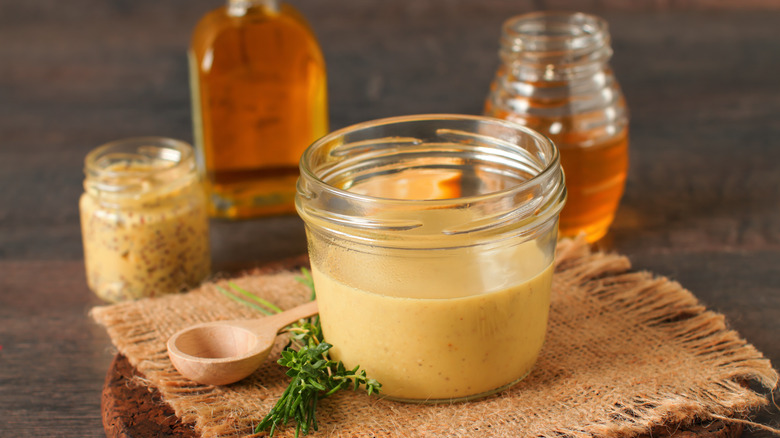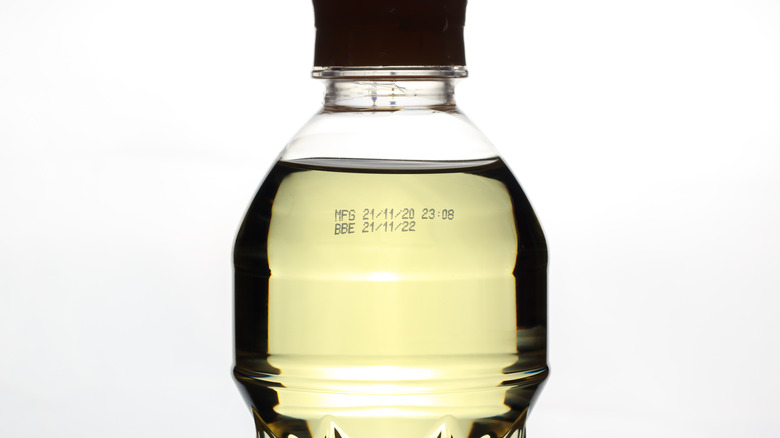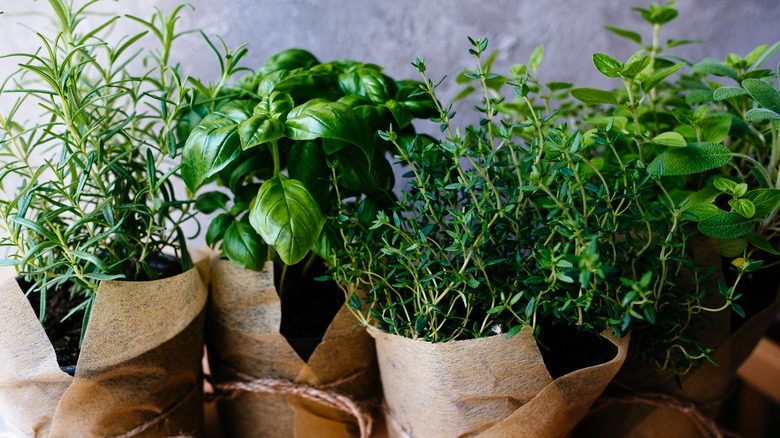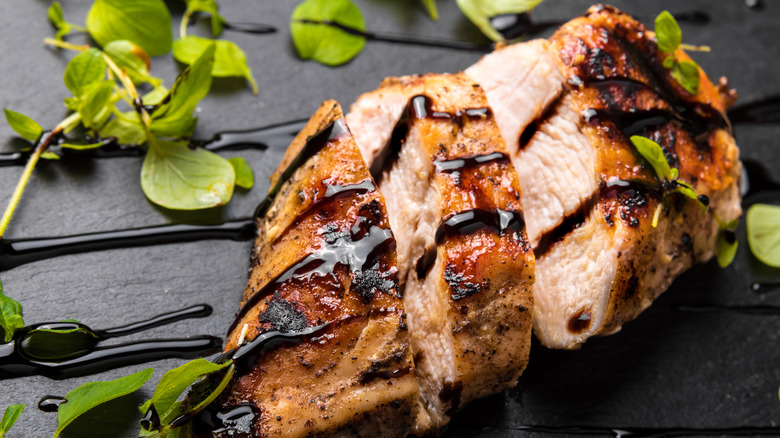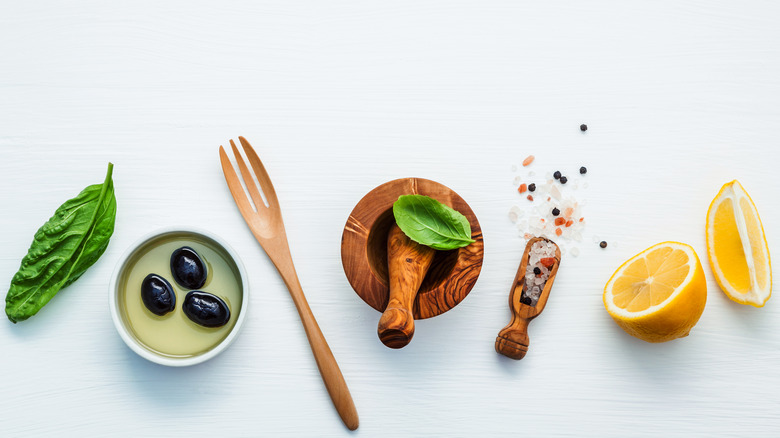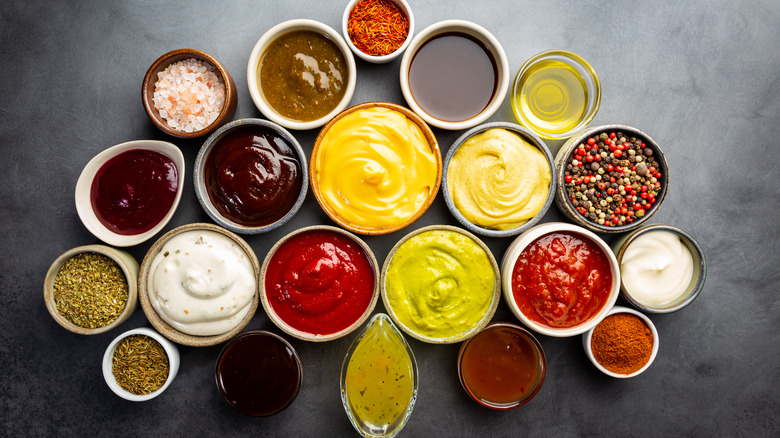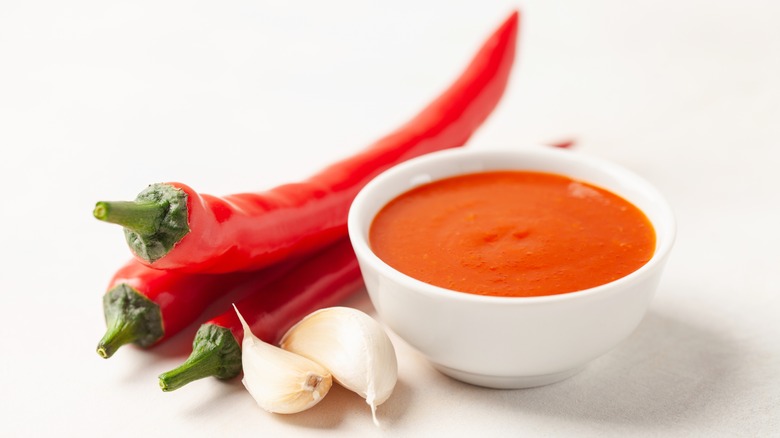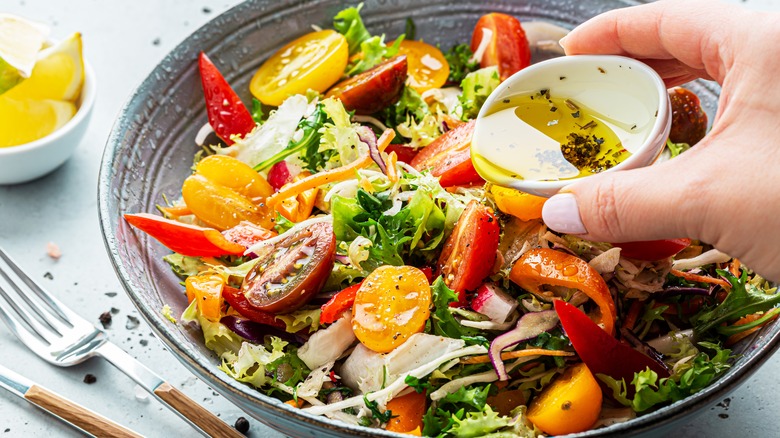12 Mistakes Everyone Makes When Making Homemade Vinaigrette
Vinegar, which comes from the French word vin aigre, meaning "sour wine,” has been used medicinally and as a food preservative since the time of Hippocrates. Nowadays, while still used both for its healing properties and to preserve certain foods, vinegar often serves as the base for many salad dressings, and is a necessary component when making a homemade vinaigrette.
Whether mindful eating or pinching pennies is your goal, making vinaigrette from scratch is an easy way to accomplish both. In order to prolong the shelf life of store-bought salad dressings, many commercial brands contain unhealthy ingredients like additives, genetically modified organisms, saturated fats, sodium, sugar, and more. Even a classic fat-free Wish-Bone Italian dressing may appear to be a healthy alternative in the salad dressing aisle, but it contains some questionable ingredients including caramel color, sodium benzoate, and calcium disodium EDTA.
However, the main ingredients on any Italian dressing label, such as the popular Olive Garden Italian, include things like distilled white vinegar, Italian herbs, garlic, salt, sugar, Romano cheese, and oil, which are common items found in almost every home kitchen and therefore make this an easy dressing to recreate at home, minus some unhealthy attributes like soybean oil and high fructose corn syrup. Not all homemade vinaigrettes are created equal, and in order to make your salad a healthy component of any meal, we've rounded up some mistakes to avoid when making vinaigrette dressing from scratch.
1. Estimating measurements for all ingredients
Too much acidity, oil, citrus, or spice may pretty much ruin any dish, so it is especially important to measure the ingredients, especially the vinegar to oil ratio, when making a homemade vinaigrette. According to Inquiring Chef, the most basic starting point to any vinaigrette is to follow a ratio of three parts oil to one part vinegar. For example, when making two servings of vinaigrette, you would use 1 tablespoon of vinegar and 3 tablespoons of oil. For four servings of vinaigrette, you would use 2 tablespoons of vinegar and 6 tablespoons of oil.
Beyond that, estimating other ingredients like salt, pepper, emulsifiers, and seasonings is acceptable, but may be a process of trial and error. Whether using precise measurements or eyeballing the ingredients as you go, the best way to test the flavor of your dressing to make sure it is cohesive is by dipping a lettuce leaf in the dressing. If it needs another dash of salt or pinch of seasoning, you can add as you go and keep taste testing with lettuce leaves to ensure the end result will pair well with your salad.
2. Using the wrong oil
Before understanding what the wrong oil means for homemade salad dressing, it's important to know what oils are recommended in a vinaigrette based on their unique color, aroma and taste. Extra virgin olive oil is hands down the most common oil recommended for homemade recipes due to its herbaceous notes and potential health benefits (via We Olive).
Other neutral-tasting oils like avocado, grapeseed, canola, or vegetable are recommended as well, and may even be combined with olive oil to make the oil flavor in the vinaigrette more subtle, and it can also be a cost-effective way to save money as neutral oils tend to be cheaper than olive oil.
More robust-tasting oils like coconut, sesame, and walnut are considerably rich for any given standard salad, but could be used for their unique flavor profile in culturally-specific salads such as adding a teaspoon of sesame oil to an Asian-inspired salad, or coconut oil to a fruit-forward salad. Infused oil is another distinctly flavorful option that should also be used in moderation.
3. Using the wrong vinegar
Much like the oil you choose, vinegar plays a key role in homemade salad dressing, and can dramatically alter the overall flavor of the vinaigrette based on the vinegar's unique profile, acidity, taste, and color, according to Cooking Light.
Balsamic vinegar is the olive oil of vinegars, meaning it is one of the most versatile vinegars to include in your homemade dressing, and pairs well with just about all salad ingredients. Wine-based vinegars are also classic choices, including red, white, and champagne wine vinegar. Sherry, apple cider, rice wine, and infused vinegar are more complex options, and need to be paired with the right oils and ingredients to match their unique flavor profiles.
The key when adding any type of vinegar is to measure it and follow the 3:1 ratio. Using too much vinegar will cause the dressing to taste too bitter and acidic, so it's best to measure the vinegar before adding it to your homemade concoction. If you've accidentally added too much vinegar, all is not lost as you can add baking soda one pinch at a time to balance the acidity until you've reached the desired flavor.
4. Leaving out the emulsifier
We've all heard the idiom that water and oil don't mix as a way to say two things don't belong together, and in actuality, it's true. According to the University of California Los Angeles Science and Food blog, in terms of homemade vinaigrette, the vinegar serves as the liquid substance, and similar to water, it won't merge with oil as the two ingredients tend to separate due to their polar and nonpolar molecules. More simply put, oil and vinegar will always have an aversion to one another, unless there's another ingredient to stabilize the emulsion.
The good news is, adding an emulsifier is a relatively simple trick to bond the ingredients in your homemade salad dressing. Common emulsifiers added to salad dressings include garlic, mustard, egg yolk, tomato paste, and honey. One important technique in successfully adding an emulsifier is to whisk, shake, or blend it into the vinegar at a high speed, and add in the oil slowly while continuing to whisk or blend the ingredients together. This ensures the oil, vinegar, and emulsifier will bond together and result in a smooth, homemade vinaigrette.
5. Skipping the mustard
Of the aforementioned emulsifying ingredients, Ina Garten and Martha Stewart both recommend mustard as a key ingredient to homemade vinaigrette, and who are we to question these two revered queens of the kitchen? According to She Knows, Ina Garten prefers to pair both Maille Wholegrain Mustard with Grey Poupon Dijon Mustard into a vinaigrette to elevate it from mediocre to extraordinary.
Stewart suggests making the most of any mustard when it's near the end of the jar or bottle by adding olive oil, salt, pepper, shallots, and lemon juice (or vinegar, which has the same acidity effect as citrus), and shaking it to create a delicious and cost-effective homemade vinaigrette.
Whether Dijon or remnants from any old mustard jar, the outcome is the same in that mustard helps emulsify any vinaigrette due to the secretion of fluid found in the mustard seed shell itself, which acts as a thickening agent when mixed with oil and vinegar or the juice of citrus.
6. Forgetting to check expiration dates
According to The Flour Handprint, buying oils with a harvest or production date listed on the bottle is crucial in order to ensure the oil is fresh. There are also certification councils that label bottles accordingly to protect consumers from purchasing rancid or expired oils. Unlike other food products, cooking oils do not include an expiration date, and rather list a "best if used by" date, which means the oil is best if used by the date recommended, and will lose its quality past that date, but will still be safe to consume (via Our Everyday Life).
The best way to determine freshness is to observe the color, taste, and smell of the oil before adding it to your homemade vinaigrette. If the oil appears cloudy, or it smells and tastes bitter, it has most likely gone bad. The best way to prevent oil from going bad is to use it by the recommended date on the bottle, and to store it in a cool, dry place. Certain oils, such as olive and walnut, tend to expire faster than others and are best stored in the refrigerator.
7. Not using fresh herbs
While it may be tempting to reach for dried parsley or Italian seasonings to add to your homemade vinaigrette, the more flavorful choice would be to use fresh herbs. Herbivore's Kitchen offers a fresh homemade herb vinaigrette recipe that features fresh parsley, oregano, and basil, which make up the majority of ingredients in this simple dressing.
If you're an avid outdoor gardener or grow your own indoor windowsill herb garden, making homemade dressing like this one is a great way to maximize your herb gardening efforts and utilize the most herbs possible in one dish, according to Art and the Kitchen.
Before adding your herbs to the salad dressing, it's important to wash and dry them before use as you do not want the herbs to water down the dressing. Other homegrown herb options for vinaigrette include cilantro, dill, and mint. These herbs can all be found in the produce section of any grocery store, but growing them yourself makes it more easily available and budget friendly.
8. Using vinaigrette only on salad
Whipping up a homemade vinaigrette for one-time use is simple and easy, but if you're going to go through the task of measuring ingredients, rinsing and chopping herbs, and whisking it all together, you may as well make enough for another meal. According to Eat by Date, vinegar-based salad dressings may last up to three or four weeks in the refrigerator, depending on the ingredients. If fresh herbs or citrus have been incorporated in the vinaigrette, the shelf life is shortened to one or two weeks.
If you've made a large batch of vinaigrette with plenty of leftovers, Premeditated Leftovers recommends repurposing the dressing as a marinade on meats. The best way to reduce food waste using this method is to divide the meat into separate containers, add the dressing, and freeze or consume it immediately. Another option for leftover vinaigrette is to add it to tuna or chicken salad, or to use it as a dressing on a sandwich or wrap.
9. Skipping sweet or salty ingredients
We've covered the fact that high quality oil and vinegar is an essential component to any homemade vinaigrette, as well as fresh herbs, and an emulsifier, particularly mustard, but there are more options for ingredients you may want to include depending on the flavor of the salad and the balance you're looking to achieve. Once you've mastered the 3:1 oil to vinegar ratio, it's time to play around with other ingredients to make the dressing sweeter, such as honey, sugar, agave nectar, and maple syrup. If the sweetener you're adding is granular, such as sugar, the best way to avoid a gritty texture is to break down the sugar in the vinegar or citrus before adding oil as sugar and salt do not dissolve in oil (via Chef Talk).
To give your homemade vinaigrette a more salty and robust flavor, try adding grated or crumbled cheeses like Romano, parmesan, or gorgonzola to the dressing. Another method for achieving a saltier flavor is by adding capers or chopping olives, but these small add-ons pack a bold punch so it's best to taste as you go and add more if needed.
10. Using too many ingredients
Although it may seem fun to play around with different flavors and textures in your vinaigrette, there is such a thing as going overboard with ingredients, so it's best to follow the Food Network's advice by keeping your recipe simple and basic. One of your goals in making homemade vinaigrette should be to scale back on overcomplicated ingredients like those listed on the back of store-bought labels, so the basic rule of thumb is to follow the acid, oil, emulsifier, and flavorings rule. When using an acid, choose either vinegar or citrus, not necessarily both as you don't want the vinaigrette to turn out overly acidic.
For a simple guideline on what ingredients to include in your dressing, keep it simple as Tasting Table recommends in order to achieve your desired flavor. In each of their five healthy dressings, the recipes do not surpass six ingredients at most, which include salt and pepper, and most can be thrown together with common pantry items.
11. Holding back on heat
Eating salad every day may seem like a boring way to live, but salads can be packed with layers of flavor and seasoning, especially if you incorporate a source of heat in your homemade dressing. According to Reddit, hot sauce and fish sauce can elevate the flavor of a dressing to a whole new level without making you sweat. Just a few drops are all it takes to bring a basic vinaigrette to a culinary masterpiece.
Mel Magazine also points out that hot sauce contains few to zero calories, making it a great addition to a salad in terms of both health and flavor. Furthermore, a study by Harvard indicates that the more spicy foods you consume, the potentially longer your life expectancy. Combining spicy foods with leafy greens and other heart-healthy vegetables may also decrease your risk of cancer, heart, and respiratory diseases, and adding hot sauce, cayenne, or red peppers to your vinaigrette is a great way to increase your intake of spice.
12. Not pairing dressing and salad ingredients
Consuming the same salad and dressing every day or week will likely get old, so it's important to mix it up if your goal is to consume more greens and stick with it. With so many different types of greens and vegetable combinations out there, it's important to pair the right dressing flavors with the ingredients of your salad. Honey and Lime offers a complete guide to pairing the right greens with the right dressing.
For example, bitter, peppery greens such as arugula, endive, and frisee require a sweeter vinaigrette made with honey or maple syrup. Softer greens tend to wilt when tossed with heavy vinegar-based dressings, so a lighter olive oil, lemon, and herb dressing pairs best with tender greens like spinach and butter leaf lettuce. A strong-flavored vinaigrette will pair best with stronger leafy greens like kale or crisp lettuce such as romaine. Dash of Sanity also recommends using kale with more potent dressings like a sesame vinaigrette, or other tangy, full-bodied dressings that pack a flavorful punch.
